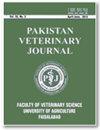2016-2017年埃及口蹄疫病毒(FMD)血清型的遗传特征及O型拓扑型EA-3新谱系的鉴定
IF 5.4
3区 农林科学
Q1 VETERINARY SCIENCES
引用次数: 10
摘要
收到:修订:接受:在线发布:2018年11月28日2019年3月1日2019年03月08日2019年04月23日从2016年12月到2017年4月,许多农民和兽医抱怨埃及各省爆发了口蹄疫。因此本研究旨在对这一时期流行的口蹄疫病毒进行表征。临床数据和疫苗接种史是从埃及10个省的9个受影响农场和27个小农户拥有的个体病例中收集的。共收集59个水疱上皮细胞,并通过实时(rt)rt-PCR检测和定量病毒。此外,通过不太敏感的常规RT-PCR分析具有足够基因组负载的阳性样品,以扩增VP1区域的全长;对扩增子进行测序并构建系统发育树。在分析的59个样本中,49个(83.1%)通过rt rt-PCR呈阳性,但只有22/39通过常规rt-PCR产生扩增子。大约19个扩增子适合测序,分别在15个、1个和3个样本中显示血清型O、A和SAT2。系统发育分析将特征菌株聚类为血清型O、拓扑型EA-3;血清型A,基因型IV的非洲拓扑型;和血清型SAT2,拓扑型VII。有趣的是,区分了血清型O拓扑型EA-3菌株的两个谱系,称为Ism-16和Alx-17。2016年,在埃及,Ism-16谱系与先前表征的病毒聚集在一起,但Alx-17谱系聚集在一个单独的分支中,这是首次报道。需要进一步的研究来评估疫苗和埃及异源循环菌株之间的交叉保护,特别是血清型O。©2019 PVJ。保留所有权利本文章由计算机程序翻译,如有差异,请以英文原文为准。
Genetic Characterization of Foot and Mouth Disease Virus (FMD) Serotypes in Egypt (2016-2017) and Identification of a New Lineage of Serotype O Topotype EA-3
Received: Revised: Accepted: Published online: November 28, 2018 March 01, 2019 March 08, 2019 April 23, 2019 From December 2016 to April 2017, many farmers and veterinarians complained about FMD outbreaks in various Egyptian governorates. Therefore; the present study aimed to characterize the circulating FMD viruses during this period. Clinical data and vaccination histories were collected from nine affected farms and 27 individual cases owned by small farmers in 10 Egyptian governorates. A total of 59 vesicular epithelia were gathered and tested by real-time (rt) RT-PCR to detect and quantify the virus. Furthermore, the positive samples with sufficient genomic loads were analyzed by the less sensitive conventional RT-PCR to amplify the full length of the VP1 region; amplicons were sequenced and phylogenetic trees were constructed. Of 59 samples analyzed, 49 (83.1%) were positive by rt RT-PCR, but only 22/39 produced amplicons by conventional RT-PCR. About 19 amplicons were suitable for sequencing and showed serotypes O, A, and SAT2 in 15, 1 and 3 samples, respectively. Phylogenetic analyses clustered the characterized strains in serotypes O, topotypes EA-3; serotype A, African topotype of genotype IV; and serotype SAT2, topotype VII, respectively. Interestingly, two lineages of serotype O topotype EA-3 strains were distinguished and referred to as Ism-16 and Alx-17. Ism-16 lineage clustered with the previously characterized viruses in Egypt in 2016, but the Alx-17 lineage clustered in a separate clade and is hereby reported for the first time. Further studies are required to evaluate the cross-protection between the vaccine and heterologous circulating strains in Egypt, especially for serotype O. ©2019 PVJ. All rights reserved
求助全文
通过发布文献求助,成功后即可免费获取论文全文。
去求助
来源期刊

Pakistan Veterinary Journal
兽医-兽医学
CiteScore
4.20
自引率
13.00%
发文量
0
审稿时长
4-8 weeks
期刊介绍:
The Pakistan Veterinary Journal (Pak Vet J), a quarterly publication, is being published regularly since 1981 by the Faculty of Veterinary Science, University of Agriculture, Faisalabad, Pakistan. It publishes original research manuscripts and review articles on health and diseases of animals including its various aspects like pathology, microbiology, pharmacology, parasitology and its treatment. The “Pak Vet J” (www.pvj.com.pk) is included in Science Citation Index Expended and has got 1.217 impact factor in JCR 2017. Among Veterinary Science Journals of the world (136), “Pak Vet J” has been i) ranked at 75th position and ii) placed Q2 in Quartile in Category. The journal is read, abstracted and indexed internationally.
 求助内容:
求助内容: 应助结果提醒方式:
应助结果提醒方式:


